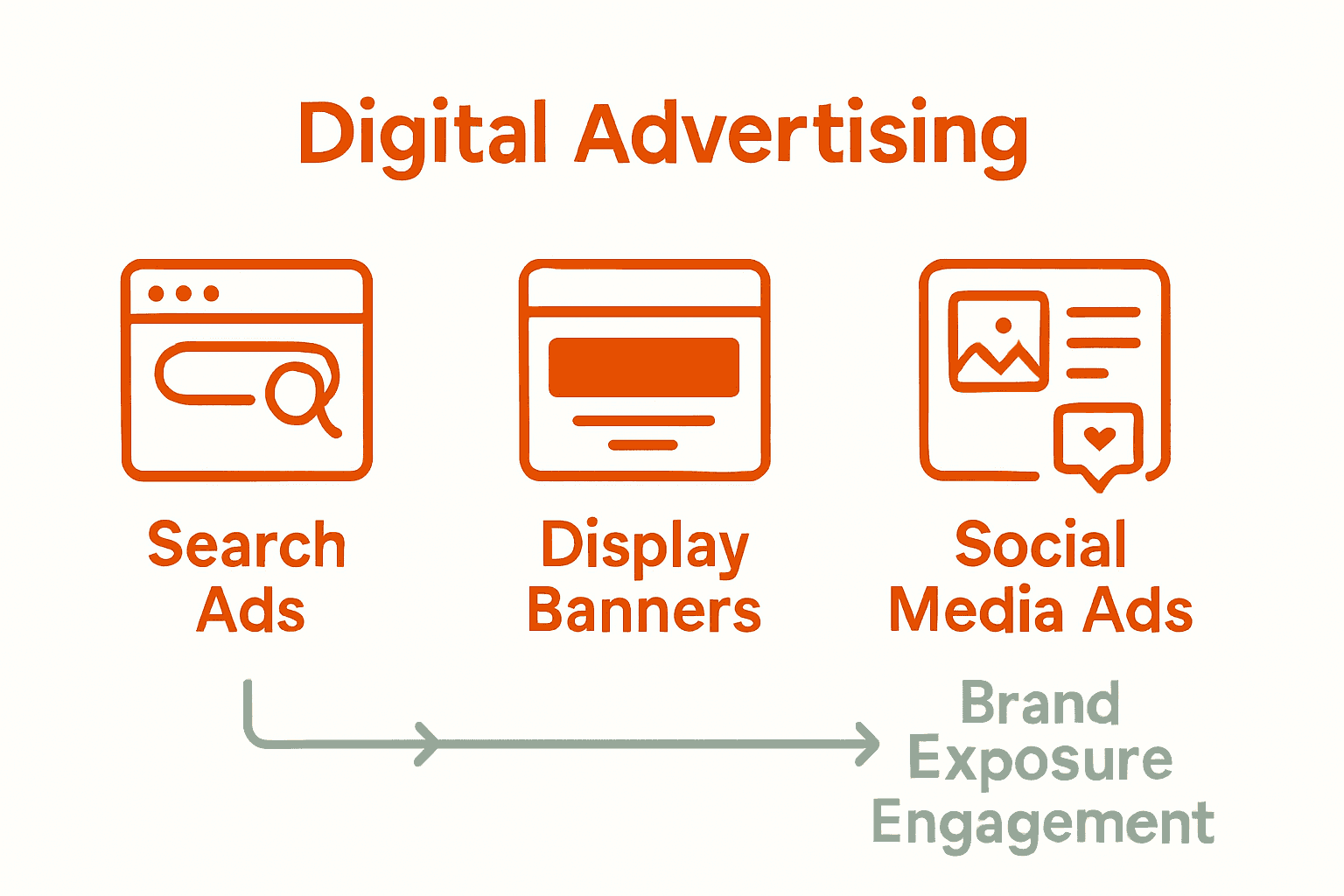Over 4.6 billion people actively use the internet worldwide, making digital advertising one of the most powerful ways for brands to connect with their audiences. As online spaces grow more crowded, understanding the core strategies behind digital advertising becomes crucial for anyone aiming to stand out. By uncovering the key elements, formats, and smarter targeting tactics, you can build campaigns that grab attention, drive results, and stay ahead in a competitive online world.
Table of Contents
- Core Concepts Of Digital Advertising
- Popular Types Of Digital Advertising Formats
- How Digital Advertising Campaigns Work
- Targeting, Costs, And Budgeting Essentials
- Measuring Success And Common Pitfalls
Key Takeaways
| Point | Details |
|---|---|
| Digital Advertising Strategies | Effective digital advertising combines SEO, content marketing, email, and paid media, requiring a data-driven approach for success. |
| Diverse Advertising Formats | Marketers should leverage various formats like search ads, display banners, and social media to maximize engagement and meet campaign objectives. |
| Campaign Development Process | Successful campaigns entail thorough market research, strategy formulation, platform selection, and continuous performance tracking. |
| Targeting and Budgeting | Precise audience targeting and effective budget allocation are crucial for optimizing ROI and ensuring impactful digital marketing campaigns. |
Core Concepts of Digital Advertising
Digital advertising represents a transformative approach to marketing that leverages online platforms and technologies to reach and engage target audiences. According to Westminster University, this dynamic field encompasses several critical strategies that businesses must understand to succeed in the modern marketplace.
The core components of digital advertising include search engine optimization (SEO), content marketing, email marketing, and paid digital advertising. Kent University highlights that these strategies require a strategic approach to analyzing online marketplaces and understanding how digital technologies impact marketing communications. Successful digital advertising means moving beyond traditional advertising methods and embracing data-driven, targeted approaches.
Key strategic elements of effective digital advertising include:
- Precise audience targeting
- Measurable campaign performance
- Real-time campaign optimization
- Multi-channel engagement strategies
- Cost-effective marketing solutions
Professional digital advertising requires continuous learning and adaptation. Marketers must stay current with emerging technologies, platform algorithms, and consumer behaviour trends to create compelling, resonant advertising experiences that cut through the digital noise and connect meaningfully with potential customers.
Popular Types of Digital Advertising Formats
Digital advertising has evolved to include multiple dynamic formats designed to capture audience attention across diverse online platforms. According to UK Government, these formats range from traditional banner advertisements to sophisticated social media display strategies.
Competition and Markets Authority identifies several prominent digital advertising formats that businesses leverage for targeted marketing:
- Search Advertising: Text-based ads appearing alongside search engine results
- Display Banners: Visual advertisements embedded within websites and apps
- Native Advertising: Sponsored content seamlessly integrated with platform design
- Video Advertisements: Engaging multimedia content across streaming platforms
- Social Media Advertising: Targeted promotions within social network environments
Successful digital advertising requires understanding each format’s unique strengths and audience engagement potential. Marketers must strategically select formats that align with their campaign objectives, target demographic preferences, and budget constraints. By combining multiple advertising formats, businesses can create comprehensive digital marketing strategies that maximize reach, engagement, and conversion potential.

Here’s a summary of popular digital advertising formats and their key strengths:
| Format | Typical Placement | Key Strengths |
|---|---|---|
| Search Advertising | Search engine results | High intent reach Measurable ROI |
| Display Banners | Websites, mobile apps | Wide visibility Brand awareness |
| Native Advertising | Newsfeeds, articles | Seamless integration High trust |
| Video Advertisements | Streaming platforms, sites | Engaging content Storytelling |
| Social Media | Social platforms, feeds | Precise targeting Viral potential |
How Digital Advertising Campaigns Work
Digital advertising campaigns represent sophisticated strategic processes that transform marketing approaches through targeted technological interventions. Westminster University emphasizes that modern campaigns leverage advanced techniques including search engine optimization, social media marketing, and emerging artificial intelligence technologies to create precise, measurable marketing experiences.
Kent University highlights the critical stages of developing successful digital advertising campaigns, which typically involve:
- Market Research: Understanding target audience demographics and behaviours
- Strategy Development: Defining campaign objectives and key performance indicators
- Platform Selection: Choosing appropriate digital channels for maximum reach
- Content Creation: Designing engaging, targeted advertising materials
- Campaign Deployment: Launching advertisements across selected platforms
- Performance Tracking: Monitoring real-time metrics and campaign effectiveness
Successful digital advertising campaigns require continuous optimization and data-driven decision making. Marketers must remain agile, using sophisticated analytics to refine targeting, adjust messaging, and maximise return on investment.
Targeting, Costs, and Budgeting Essentials
Digital marketing targeting represents a sophisticated approach to reaching precise audience segments with strategic precision. UK Government highlights the critical importance of understanding legal requirements and data sourcing strategies when developing targeted digital marketing approaches.
NCFE emphasizes that effective digital marketing budgeting involves comprehensive strategy development that considers multiple financial and strategic dimensions. Key targeting and budgeting considerations include:
- Demographic Precision: Narrow audience selection based on age, location, interests
- Cost-Per-Click (CPC) Management: Controlling spending through intelligent bid strategies
- Audience Segmentation: Creating tailored messaging for specific consumer groups
- Budget Allocation: Distributing resources across multiple digital platforms
- Performance Tracking: Measuring return on investment for each campaign segment
Successful digital advertising requires a nuanced approach to financial planning and audience engagement. Marketers must balance sophisticated targeting technologies with prudent budget management, continuously refining their strategies to maximize impact while maintaining cost-effectiveness. By implementing data-driven targeting methods and maintaining flexible budgeting frameworks, businesses can create powerful, efficient digital advertising campaigns that deliver meaningful results.
Measuring Success and Common Pitfalls
Digital advertising success requires sophisticated measurement techniques and a comprehensive understanding of potential challenges. Government Communication Service provides a robust framework for evaluating digital campaign performance through critical key performance indicators (KPIs) that go beyond traditional marketing metrics.
UK Government Communications recommends establishing SMART objectives to effectively track and analyse digital marketing outcomes. Key metrics and potential pitfalls include:
- Reach: Total number of unique audience members
- Engagement: Interaction rates, click-throughs, and time spent
- Conversion: Tangible actions taken by potential customers
- Return on Investment (ROI): Financial performance of advertising spend
- Audience Insights: Understanding demographic response patterns
Successful digital advertising demands continuous monitoring and adaptive strategies. Marketers must remain vigilant against common pitfalls such as inadequate audience targeting, inconsistent messaging, and failure to leverage real-time analytics. By maintaining a data-driven approach, businesses can transform potential challenges into opportunities for strategic improvement and more effective digital marketing campaigns.
Elevate Your Brand with Custom Digital Advertising and Mat Solutions
Understanding digital advertising basics means recognising how targeted, customised marketing can connect with your audience in meaningful ways. Just as the article highlights the importance of precise audience targeting and multi-channel engagement, your business environment also benefits from tailored solutions that speak directly to your customers’ needs. When it comes to physical spaces, first impressions matter. At Mats4U, we provide bespoke mats designed to complement your branding and support your digital efforts by enhancing your customer experience on site.
Why settle for generic when you can:
- Create a branded entrance with personalised logo mats that reinforce your message
- Choose from a range of industry-specific mats that blend functionality and style
- Optimise safety and aesthetics across retail, hospitality, or office environments

Bring your targeted digital strategy offline with impactful, customisable floor coverings available now at Mats4U. Explore our extensive product range and take the first step towards a polished, professional space that reflects your marketing goals. Don’t wait to transform your business presence—visit Mats4U today and discover how tailored mats can support your digital advertising success.
Frequently Asked Questions
What are the core components of digital advertising?
Digital advertising comprises several core components, including search engine optimization (SEO), content marketing, email marketing, and paid digital advertising. Understanding these components is essential for successful marketing strategies in the online space.
How do digital advertising campaigns work?
Digital advertising campaigns involve a structured process that includes market research, strategy development, platform selection, content creation, campaign deployment, and performance tracking. This process helps businesses target their audiences effectively and measure their advertising success.
What types of formats are available in digital advertising?
Popular formats in digital advertising include search advertising, display banners, native advertising, video advertisements, and social media advertising. Each format serves unique purposes and can engage audiences in different ways, depending on campaign objectives.

How do I measure the success of a digital advertising campaign?
Success in digital advertising can be measured using key performance indicators (KPIs) such as reach, engagement, conversion rates, return on investment (ROI), and audience insights. Establishing SMART objectives can help track and analyze marketing outcomes effectively.









